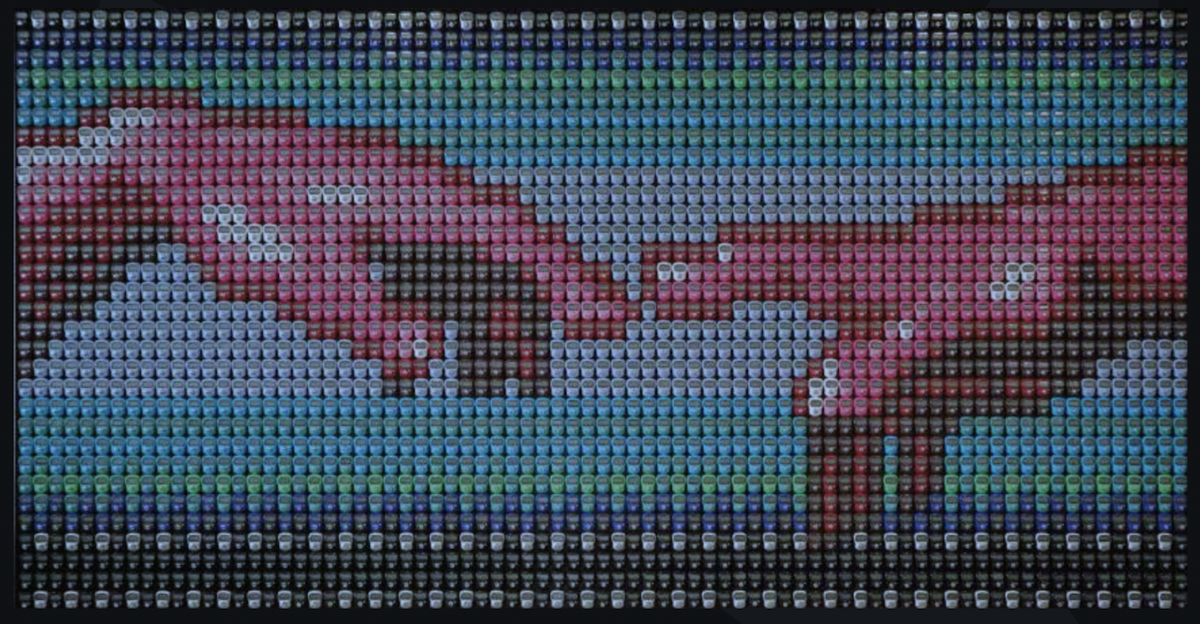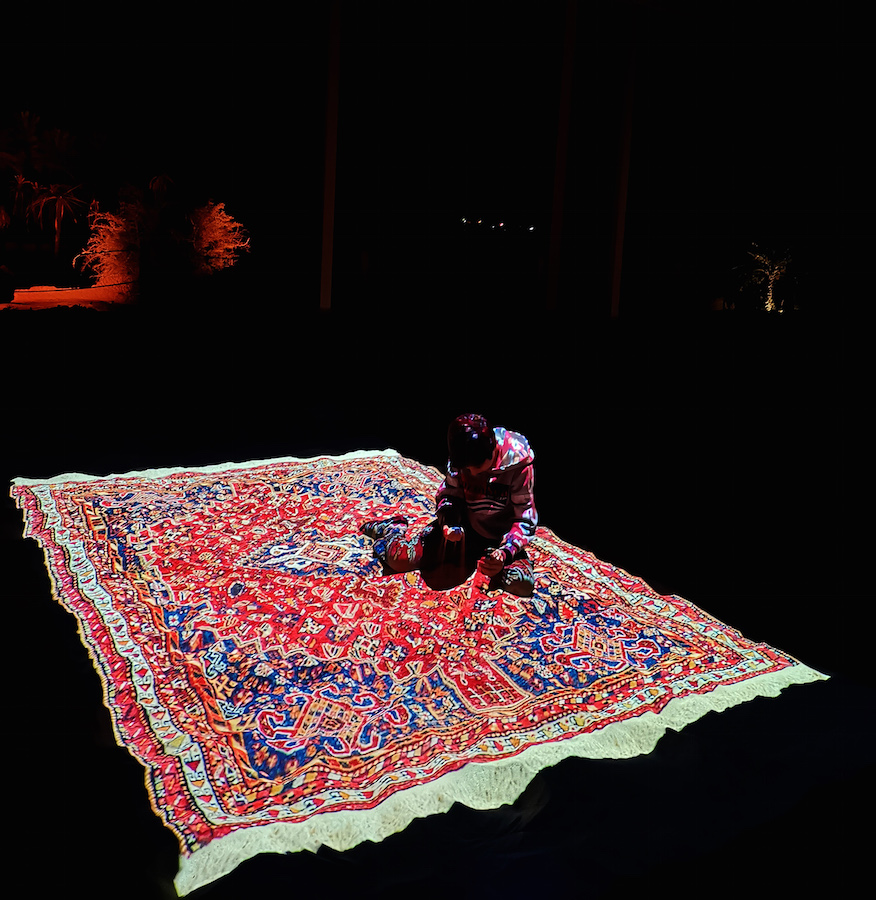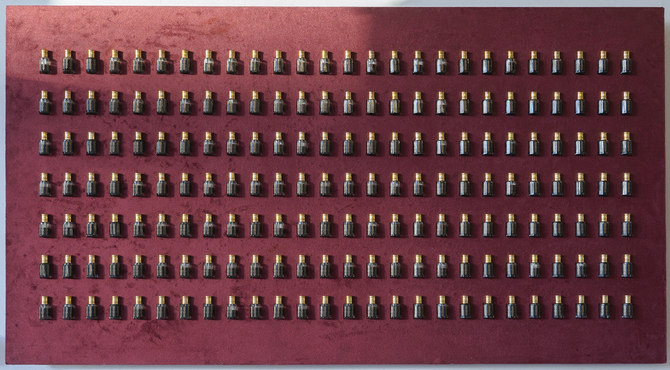FORMENTERA: “We’ve spent the last two years looking at the cultural identity in the Arab world from a sociological perspective,” says Mona Al-Abdallah, co-curator of “Re-composing,” an exhibition at the Palazzo Bembo in Venice dedicated to Saudi-based artists. Al-Abdallah co-founded the 369 Art Gallery in Jeddah in 2014 with her sister Maya (the other co-curator of “Re-composing”). The gallery is moving to Riyadh this year.
“We chose to look at Saudi-based artists for this exhibition because Saudi Arabia is alive and has a voice. It’s both ancient and new. There are artists who are only 18 in this show. I’m amazed by their proximity to Saudi’s process of becoming and what this says about the regeneration of Arab culture.”

Hmoud Al-Attawi, ‘Connection.’ (Supplied)
While it can often seem like the same handful of artists constantly appear in Saudi biennials, many of the artists participating in this exhibition are lesser known, such as the pop-culture-influenced Saudi millennial who goes by the name Rexchouk, whose “Pass the Bukhoor” (2022) places lime-green, wide-eyed men and women in traditional garb against a palm tree-lined setting, where they cleanse themselves with ‘bukhoor,’ the scent burner used at home and in ritual gatherings across the Arabian peninsula.
Then there’s Mariam Almesawi, an artist who is also a “braille language practitioner and mental health disability specialist,” according to her statement, but who you will be hard-pressed to find anything about online. Her deceptively simple video “Folkor Al-Arab” (2022) depicts a rotating female figure wearing a plain, white djellaba with black braids covering her face.
Obaid Alsafi, who emerged last year with a Misk Art Grant, combines new media, artificial intelligence and Arabic poetry in his art practice. His work “Desert Insight” (2022) is an imaginary clock framed with a circle of sand. At its center is a programmed monitor showing figures in kaleidoscopic form — an evocation of both geological time and what the artist calls “virtual time.” Meanwhile, in a comment on rapid urban development and migration within the Kingdom, Saeed Al-Gamhawi’s “My Mother’s Rug” (2021), an intricate projection which was exhibited at Noor Riyadh 2021, digitizes an old family rug in an effort to preserve time.

Saeed El-Gamhawi, ‘My Mother's Rug.’ (Supplied)
The theme of “Re-composing” evokes an ephemeral idea of fluid identities or the sense of a musical arrangement, and re-arrangement, but there’s a strong sense of materiality and material culture in the exhibition. “Agar” (2022), by filmmaker Deyaa Youssef, for example, is a haunting, textural video with a devotional quality, featuring a woman wearing an embroidered abaya, touching on water as sacred, while Khulod Albugami’s sculpture “Terhal” (2021) is a woolly figure on wooden legs, inspired by tent structures and desert adaptation. Albugami — among the more established artists in the show — draws from her Bedouin cultural heritage. In a similar vein, Swiss-Syrian-Moroccan Houda Terjuman creates a miniature palm tree floating above a green bed using copper plaster sponge and sawdust wire (“Uprooted Palm,” 2021).
There are some dramatic sculptural aesthetics on show. Abha-born Syrian artist Hatem Al-Ahmad ties tongue depressors together in a wall-sized flowing sculpture called “Shlonak” (2022), indexing illness (in the 19th century, depressors were used as a sign of the plague).
“This was a deeply collaborative process,” Al-Abdallah explains. “We thought that the work needed to be a fluid form, like a tongue that reflects the fluidity of language.” Interestingly the question, “Shou lonak?” - meaning what is your color — which developed as a colloquialism during that time has evolved into “Shlonak?” (How are you?)
In “Connection” (2019), Hmoud Al-Attawi evokes pixelated fingers touching, inspired by Michelangelo’s “The Creation of Adam.” He uses Islamic rings that measure the number of prayer beads, since the work represents a connection to the divine through fingers and counting. “Al-Attawi and Saad Howede, who share Wasm studio in Riyadh, are very research-driven,” Al-Abdullah says. “Sometimes they work on a project conceptually for a year before executing it. We believe in them and think they are going to be the next big thing.”
In “Tola Petroleum” (2019), Howede creates a grid consisting of rows of oud bottles filled with petroleum, a sharp look at traditional signifiers of Arabian culture and their interchangeability. It is a neat encapsulation of how this exhibition — as a snapshot of contemporary art practice in Saudi Arabia — indicates that ancestral traditions form a significant part, existing side-by-side with cultural change.


















